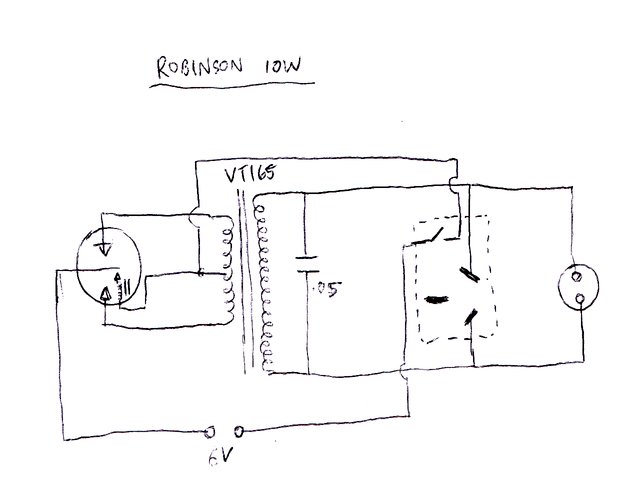Of my shaver inverters, this one is the
ultimate in simplicity. It runs from 6VDC and produces 240V at 10W. Construction
is compact, not much larger than the power point itself.
There is also a B22 bayonet light socket
provided, as bayonet plugs were still common on many appliances, particularly
shavers, at the time.
The construction suggests the immediate
post war era.
This rather descriptive label doesn't let the user forget that he
should be "clean and freshly shaven".
The smaller front label gives specifications which do not add up.
1A at 6V is 6W. Allowing for the the vibrator reed and transformer losses,
a 10W load will draw at least 2A.
It would seem that H.E. Robinson was a backyard manufacturer, of the kind that was common back then. It's hard to imagine why someone would bother patenting such a device when it uses well known technology. He must have thought his inverter would be very reliable because the casing was riveted together.
For convenience a standard bayonet socket is provided. A bakelite
dummy plug is inserted when not in use, presumably to lessen the risk of
electric shock.
It is harder to imagine a simpler inverter. Even the vibrator has
no casing.
The Circuit.

Clearly, it's harder to imagine an inverter
any more simple than this one. A standard non synchronous vibrator circuit
is used. Buffer capacitance is .05uF. As this was a paper capacitor, I
replaced it with a .047uF 2kV polyester type. The supply lead was a length
of rubber figure eight cable which had become brittle so it was also replaced.
The output socket is a modified HPM domestic
power point. Note that it is from the era (1940's), when the upside down
pin arrangement was in vogue. Normally, the switch is linked to the live
pin, but here the brass link has been drilled out so the switch is isolated
from the 240V output. Instead, it switches the 6V supply. In parallel with
the power point is a Ring Grip bayonet socket.
The transformer part number suggests a
Ferguson type. There is no mention of it in their catalog, but this is
not surprising as it is likely to be a special type. The reason for this
is the secondary is a single 240V winding, whereas it would normally be
centretapped for a full wave rectifier.
The bare vibrator is simply screwed to a piece of elephanthide insulating
material.
The vibrator is an Oak/MSP 6V non synchronous type with no can. It would appear that Mr. Robinson was able to purchase them from MSP without the can, as I have never seen the stamping "6V DC" on the side of the frame on any other normal MSP type. It would be the same as used in the V5105. To mount the vibrator, it has had the stack bolts replaced with longer ones which secure it to a strip of insulating material which is then riveted to the chassis. The vibrator is of course permanently wired in. Evidently, Mr. Robinson was aware of the superior reliability of the Oak design.
Output waveform suggests slightly more buffer capacitance might
be in order, but no arcing is visible.
The inverter works as it should without
any contact arcing. The transformer looks a little on the small size, and
it would be unwise to exceed the 10W rating. There is no fuse.
As there is no RF filtering, and with
the low output power, the uses for this inverter are rather limited. It
could be used for low power compact fluorescent lamps, USB chargers, and
many plugpack powered appliances, but any kind of radio receiver is likely
to suffer interference. Unfortunately even though the output is AC, it
won't work most vibrator type shavers because of the 100c/s frequency.
